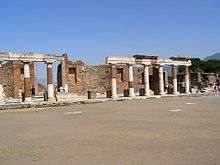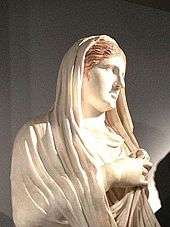Eumachia
Eumachia was the public priestess of the Imperial cult in Pompeii in the 1st century CE as well as the matron of the Fullers guild. She is known primarily from inscriptions on a large public building which she financed and dedicated to Pietas and Concordia Augusta.[1][2]

History and significance
Eumachia was the daughter of Lucius Eumachius, who possibly had amassed a large fortune as a manufacturer of bricks, tiles and amphorae. She married Marcus Numistrius Fronto, who may have held the important office of duovir. The Numistrii were one of Pompeii's oldest and most powerful families, and it is possible that when Numistrius died he left his wealth to Eumachia and their son. All that is certain is that Eumachia was able to use her wealth and social standing to obtain the position of public priestess of the goddess Venus Pompeiana, and she became a successful patronus of the economically significant guild of fullers, the guild which consisted of tanners, dyers and clothing-makers.[3][4]
Eumachia is important as an example of how a Roman woman of non-imperial/non-aristocratic descent could become an important figure in a community and involved in public affairs. She is seen as representative for the increasing involvement of women in politics, using the power of a public priestess, the only political office able to be held by a women for social mobility.[5]
Building of Eumachia

The building of Eumachia, the largest building near the forum of Pompeii, is commonly broken down into three parts, the chalcidicum, the porticus and the crypta. The chalcidicum encompasses the front of the building and is an important part of the continuous portico running along the east of the forum. The porticus is a four sided colonnade surrounding a large court yard. Finally the crypta is a large corridor behind the porticus on the north east and south sides, separated from the porticus by a single wall that has windows that were probably once shuttered, in earlier descriptions there were even cisterns, vats, basins, and stone tables in the courtyard. In the center of the court yard, that is said to have been paved of stone slabs, there is a stone block with an iron ring that covered an underground cistern.[6] The dating for the building is somewhat vague, coming in somewhere between 9 BC and 22 CE. A Marcus Numistrius Fronto had a post-mortem inscription dedicated to him on the building, he held the office of duumvir in 3 CE, for this reason it is believed that he was more likely to have been Eumachia's husband rather than her son,[7] at the same time there is a idealized statue of Eumachia dressed in a tunic, stola and cloak in a niche toward the back of the building.
The actual purpose of the building is unknown, with some of the likely theories in no meaningful order, being: 1. A market place for goods, especially those sold by the fullers' guild of which Eumachia was the matron.[7] 2. A headquarters for the fullers' guild, where they washed, stretched and dyed wool. With the actual Fulling done off site because of the smell.[8] 3. A headquarters for the fullers guild, where they did everything involved with the fulling process, with the idea that smells were of little concern in an ancient city before the invention of modern sewage.[7]
The building as a whole is dedicated to Augustian Concord and Piety, thought to be in the image if Livia. In front of the building there are bases of what were once statues of Romulus and Aeneas. Paintings of the street of Abundance, where the building is located, show Aeneas leading his family from Troy and Romulus holding a Spolia opima.[9]
Euergetism
By using her immense wealth to finance a large public works project, Eumachia was engaging in the socio-political phenomenon of voluntary gift-giving known as euergetism, which exerted an influence on the wealthy people of her time period.[10] In the early Roman empire, wealthy citizens increasingly donated their wealth to groups in their communities in return for public honors.[11]
Statue

In response to her generosity, and symbolic of her power and social status, the fullers built a statue depicting Eumachia in the veiled form of a priestess. They inscribed into its foundation a dedication.[12] The rough translation of this inscription is: "to Eumachia, daughter of Lucius, public priestess of Pompeian Venus, from the fullers."[13] See Corpus Inscriptionum Latinarum: "EVMACHIAE L F SACERD PVBL FVLLONES,".[14]
References
- Lefkowitz, Mary R., and Maureen B. Fant. Women's Life in Greece and Rome. London: Duckworth, 1982. 259.
- James, Sharon L.; Dillon, Sheila, eds. (13 February 2012). A companion to women in the ancient world. Chichester, West Sussex: Wiley-Blackwell. p. 405. ISBN 9781444355000.
- "Eumachia: Dedicatory Inscriptions ILS 3785, 6368".
- "E is for Eumachius". 24 November 2015.
- Salisbury, Joyce E. "Eumachia." Encyclopedia of Women in the Ancient World. Santa Barbara: Abc-Clio, 2001.
- Moeller, Walter O. (1976). The wool trade of ancient Pompeii. Leiden: Brill. ISBN 90-04-04494-9. OCLC 2844987.
- Cooley, Alison. Pompeii and Herculaneum: a sourcebook. Cooley, M. G. L. (Melvin George Lowe) (Second ed.). London. ISBN 9780415666794. OCLC 841187018.
- Amery, Colin (2002). The lost world of Pompeii. Curran, Brian., J. Paul Getty Museum., World Monuments Fund (New York, N.Y.). Los Angeles: J. Paul Getty Museum. ISBN 0-89236-687-7. OCLC 51311096.
- Zanker, Paul (1998). Pompeii: public and private life. Cambridge, Mass.: Harvard University Press. ISBN 0-674-68966-6. OCLC 39143166.
- Hornblower, Simon, and Antony Spawforth, eds. "Pompeii." Oxford Companion to Classical Civilization. Oxford: Oxford UP, 1998.
- Zuiderhoek, Arjan (2016). "Oxford Research Encyclopedia of Classics". doi:10.1093/acrefore/9780199381135.013.2533. ISBN 9780199381135.
|chapter=ignored (help) - Can be seen here
- Boatwright, Mary T., Daniel J. Gargola, and Richard J. Talbert. A Brief History of the Romans. New York: Oxford UP, 2006. 217.
- CIL, vol. X, no. 813; Pompeii, first century A.D.
| Wikimedia Commons has media related to Statue of Eumachia from Pompeii. |